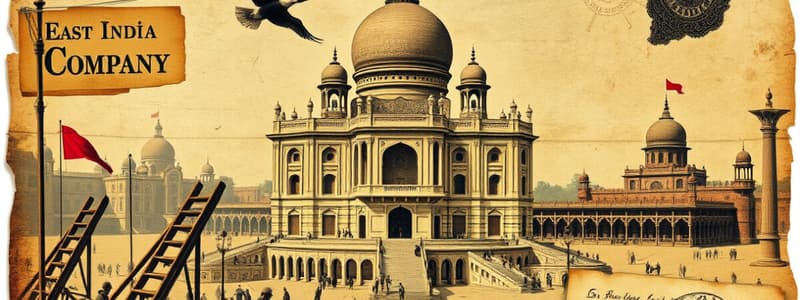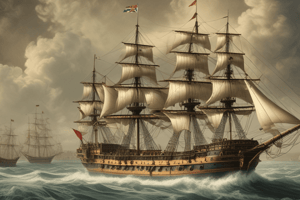Podcast
Questions and Answers
What significant event occurred in 1615 regarding the East India Company?
What significant event occurred in 1615 regarding the East India Company?
- The Company received the golden farman from the Sultan of Golconda.
- The establishment of a permanent factory at Surat.
- The arrival of Sir Thomas Roe at Jahangir’s court. (correct)
- The first factory was established in the south at Masulipatnam.
Which ruler granted the East India Company a farman for trade in Bengal in 1667?
Which ruler granted the East India Company a farman for trade in Bengal in 1667?
- Damarla Venkatadri Nayaka
- Farrukhsiyar
- Aurangzeb (correct)
- Jahangir
When did the East India Company establish its first factory in east India?
When did the East India Company establish its first factory in east India?
- 1616
- 1632
- 1651
- 1633 (correct)
What was the significance of the farman issued by Mughal emperor Farrukhsiyar in 1717?
What was the significance of the farman issued by Mughal emperor Farrukhsiyar in 1717?
Who was the Portuguese governor responsible for the capital change from Cochin to Goa?
Who was the Portuguese governor responsible for the capital change from Cochin to Goa?
Which event marked the establishment of a permanent factory for the East India Company?
Which event marked the establishment of a permanent factory for the East India Company?
In which year was Bombay given to the British ruler Charles II as a dowry?
In which year was Bombay given to the British ruler Charles II as a dowry?
Which of the following events occurred first in the timeline of the East India Company?
Which of the following events occurred first in the timeline of the East India Company?
Which trade-related permission was granted to the East India Company by the Mughal governor of Surat in 1611?
Which trade-related permission was granted to the East India Company by the Mughal governor of Surat in 1611?
What role did John Mildenhall play in the early events of British trade in India?
What role did John Mildenhall play in the early events of British trade in India?
Flashcards are hidden until you start studying
Study Notes
Establishment and Growth of Trading Companies
- 1600 marked the founding of the East India Company, which initiated British trade in the Indian subcontinent.
- William Hawkins arrived at Jahangir’s court in 1609, enhancing diplomatic relations and trade opportunities.
- In 1611, Captain Middleton gained permission from the Mughal governor of Surat for the Company to trade there, facilitating English commerce.
- The establishment of the first permanent factory of the East India Company in Surat occurred in 1613, solidifying their presence.
- Sir Thomas Roe, ambassador of King James I, arrived in 1615 at Jahangir’s court and secured two farmans by 1618 to ensure free trade and exemption from tolls.
- The first factory in southern India was set up at Masulipatnam in 1616, expanding the Company's operational reach.
- A significant golden farman from the Sultan of Golconda in 1632 guaranteed the safety and prosperity of the Company's trade interests.
- In 1633, the Company established its first factory in Eastern India at Hariharpur, Balasore in Odisha.
- The Company acquired the lease of Madras in 1639 from local ruler Damarla Venkatadri Nayaka, confirming their foothold in southern India.
- Permission to trade at Hooghly in Bengal was granted to the Company in 1651, further enhancing their trading network.
- 1662 saw Charles II receive Bombay as dowry from the Portuguese princess Catherine of Braganza, increasing British territorial control.
- Aurangzeb issued a farman for trade in Bengal in 1667, supporting the Company's commercial activities.
- In 1691, an imperial order mandated the Company to continue trading in Bengal in exchange for an annual payment of Rs 3,000.
- The farman issued by Mughal Emperor Farrukhsiyar in 1717, known as the Magna Carta of the Company, bestowed substantial trade concessions to the East India Company.
Context of Portuguese and Other European Expansions
- The Portuguese influence began with the arrival of traveler Barthalomodianz at Cape of Goodhope in 1486.
- Significant developments started with Vasco da Gama's arrival in Calicut in 1498, marking the beginning of Portuguese maritime dominance in India.
- Vasco de Gama returned to India for a second visit in 1501, fortifying Portuguese trade routes.
- In 1509, Governor Alphonso de Albuquerque reached India, marking critical military and trade expansions.
- Albuquerque captured Goa from Bijapur in 1510, securing it as a key Portuguese colony.
- Nino da Cunha became the Portuguese governor who shifted the capital from Cochin to Goa in 1530, enhancing administrative control.
- The Portuguese secured Diu and Basin from Bahadur Shah of Gujarat in 1534, further expanding their settlements.
- 1599 saw British adventurer Mildenhall arrive in India by land, reflecting early forms of English exploration and trade.
- The English trading company "Merchant Adventures" was formed in 1599, signaling the start of structured British trading efforts.
- The Dutch East India Company was established in 1602, representing the competition among European powers for control in the Indian ocean.
- The Portuguese transferred Bombay to the British ruler Charles II in 1661, further ceding control of their territories.
- The French East India Company was founded in 1664, indicating the growing involvement of European powers in Indian trade.
- Calcutta city was founded in 1690 by Job Chornock, establishing a key city for British trade in India.
- In 1500, Pedro Alvarez Cabral further explored India, contributing to the Portuguese expansion in the region.
- Qasim Khan, a Mughal Chieftain, famously defeated the Portuguese on the Hooghly coast in 1631, showcasing regional resistance to foreign expansion.
Studying That Suits You
Use AI to generate personalized quizzes and flashcards to suit your learning preferences.




